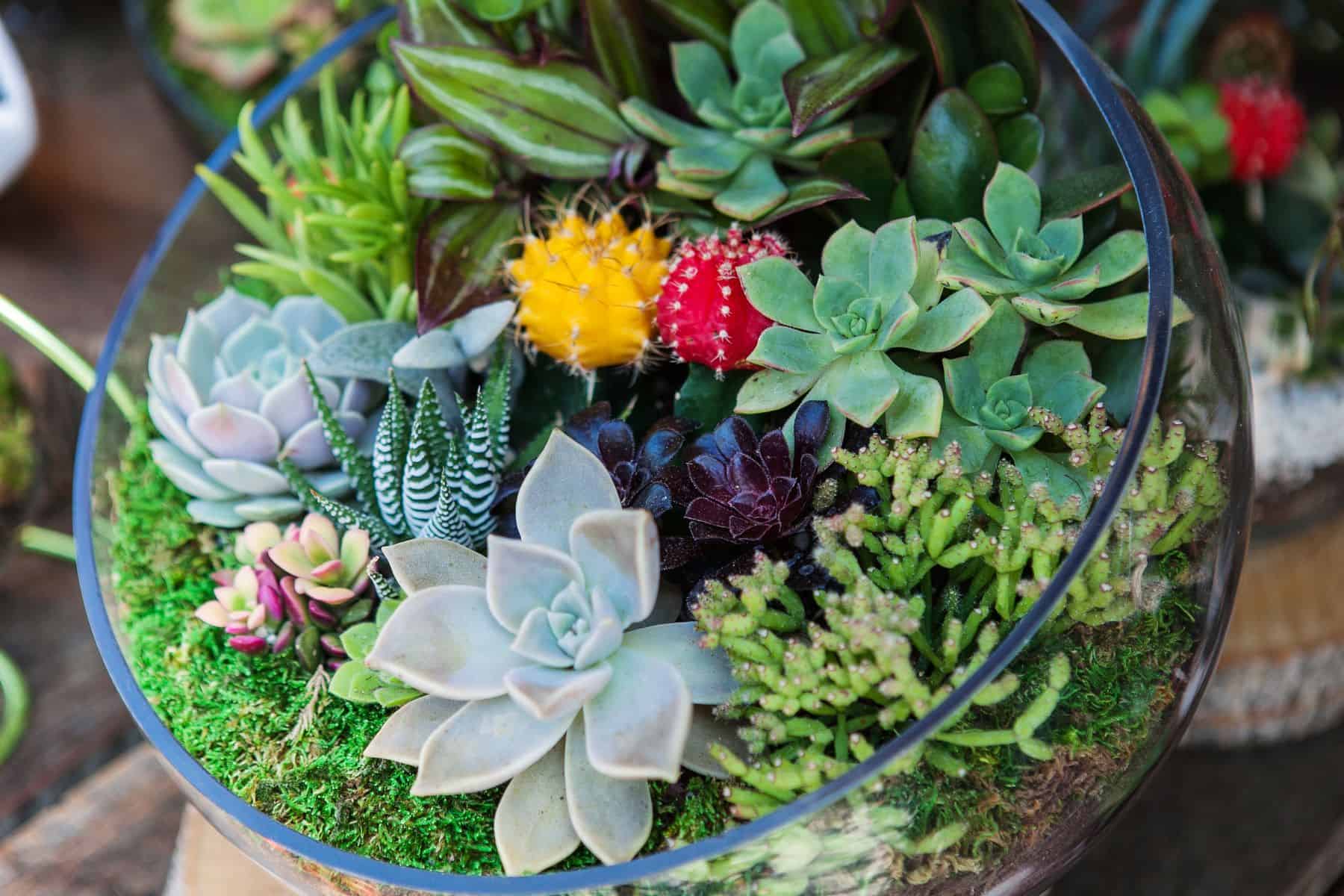
When you make your own terrarium, you create a miniature garden for your home or office. It’s easy, and you will enjoy it for years.
You can make your own DIY (do-it-yourself) terrarium using basic gardening supplies and materials from around the house. If you are not familiar with terrariums, think of it as a miniature contained garden. A terrarium is sort of like an aquarium, but for plants!
A terrarium is a great addition to any indoor space. It makes a wonderful gift, too. Plus, making your own DIY miniature garden is a fun indoor gardening project when the weather turns cold.
What is a Terrarium?
A terrarium is a simple garden enclosed in glass or plastic. One benefit of growing plants inside a terrarium is the ability to control the growing environment and adapt it to specific plant materials.
A closed terrarium allows you to maintain a humid atmosphere for plants like ferns, polka dot plant, and Venus flytrap. You can also use your DIY terrarium to start seeds, spores, or cuttings. Open terrariums work well for many houseplants, especially plants requiring lower humidity.
Containers for Your Terrarium
Many different types of containers can be used to house your terrarium – from mason jars to fish tanks. The size and style of the container depends on what you want to grow.
Clear, colorless glass or plastic allows for maximum light penetration. Containers with lids will maintain high humidity and are ideal for tropical and bog plants. Choose open containers for sun-loving plants, air plants, and succulents.
Look around the house for items that match your style, like an old glass tea pot or decorative jar. Clean the container with hot, soapy water, rinse thoroughly, and allow to dry. Now you are ready to assemble the terrarium.
Check out the terrarium containers on Amazon.
Home Garden and Homestead is proud to be an Amazon Affiliate partner. We receive a small commission on eligible purchases. Thanks for supporting this website!
Choosing Soil for Your Terrarium
When you make your own terrarium, it’s important to start with healthy soil. Because closed containers retain high humidity, they can be prone to disease. Use a sterilized soil to avoid disease problems. Commercial mixes are sterilized and contain a variety of materials that provide good moisture retention. Choose a sandier soil for cacti and succulents. Most commercial mixes contain a slow release fertilizer, so it is not necessary to add fertilizer to the media.
Add about 1 ½ to 3 inches of soil to the container. Moistening the soil before adding to the container will keep dust from covering the inside walls of your terrarium. If your container has a small opening, roll a piece of paper to make a funnel. Then add the soil through your homemade funnel.
DIY Tip: Some people like to place decorative stone or sand in the bottom of the container before adding soil. This helps to keep the soil from becoming waterlogged.
What Plants to Use in a Terrarium
Many plants are suitable for growing in a terrarium. When you make your own terrarium, select plants that match your intended planting style. For example, you might choose woodland, tropical, or desert plants.
It is a good idea to include plants with different heights, textures, and colors for visual interest. Also consider light and moisture requirements as you select plants. It is best to use plants that have similar growing requirements. Also make sure the plants and will work in the container size you are using. Plants can be purchased at a local garden center or online at www.logees.com.
Interesting Foliage Plants:
- Nerve plant, Fittonia albivenis
- Polka dot plant, Hypoestes phyllostachya
- Purple passion plant, Gynura aurantiaca
- Rex begonia, Begonia rex-cultorum
- Earth star, Cryptanthus bivittatus
- Waffle plant, Hemigraphis exotica
- Aluminum Plant, Pilea cadierei
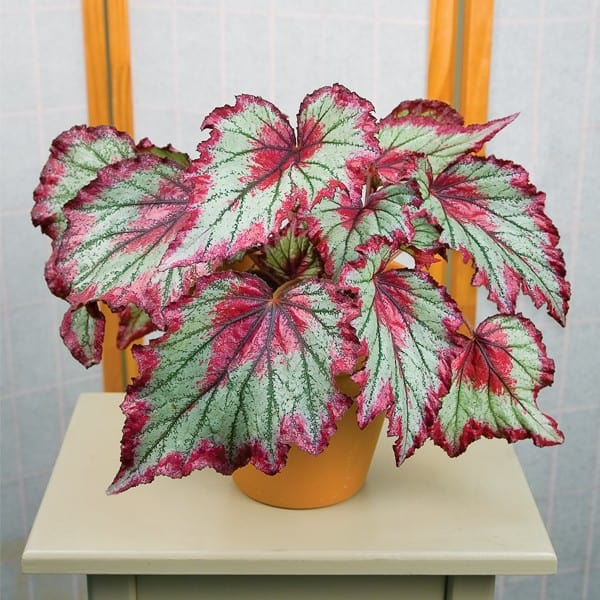
Fine Foliage Plants:
- Baby Tears, Soleirolia soleirolii
- Golden moneywort, Lysimachia nummularia ‘Aurea’
- Button Fern, Pellaea rotundifolia
- Mosses
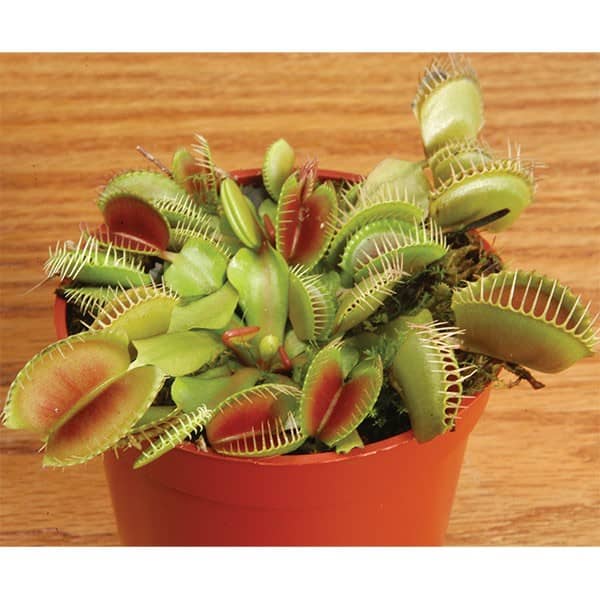
Carnivorous Plants:
- Venus flytrap, Dionaea muscipula
- Sundew, Drosera capensis
Focal Point Plants:
- African violet, Saintpaulia species
- Arrowhead plant, Syngonium podophyllum
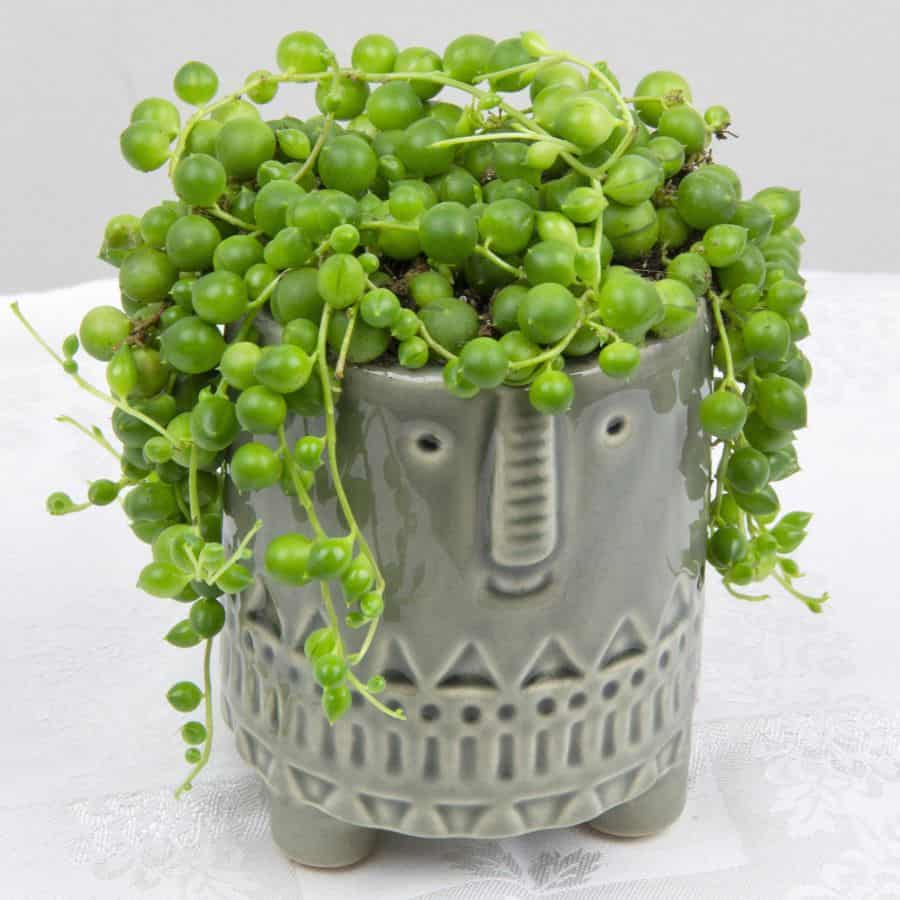
Succulents:
- Stonecrop, Sedum species
- Hens and chicks, Sempervivum species
- Paddle plant, Kalanchoe luciae
- Zebra cactus, Haworthia attenuate
- String of pearls, Senecio rowleyanus
- Echeveria, Echeveria species
- Ghost plant, Crassula graptopetalum
Planting Your Own Terrarium
When you make your own terrarium, one of the most exciting steps is placing the plants inside the container. Before adding plants, lay them out on the table to find a good design. Avoid clumping several variegated or unusual plants together as they will compete visually.
Set taller plants to the back and lower material in front. Course-textured plants make a nice focal point near the front of the terrarium. Also visualize any decorative elements you plan to add, such as rocks or driftwood.
Remove plants from their pots and clean excess growing media from their roots. A few household items will help you assemble the terrarium. Use a large kitchen spoon to dig planting holes in the soil. Tongs, long-handled tweezers, or chop sticks work great for placing plants inside containers with narrow openings. As you place plants inside the terrarium, avoid having leaves touch the walls.
After plants are set, you may need to wash soil off the foliage and sides of the container using a gentle stream of water. Allow the foliage to completely dry before closing the lid. Check the soil. It should be damp, but not saturated. If too much water has been added, tip the terrarium at an angle and use a paper towel to wick out excess water.
How to Water Your Terrarium
The type and amount of care a terrarium requires will vary according to the type of container and plant materials. A closed terrarium is designed to require very little care. Once established, a closed terrarium will develop rain cycles where water condenses on the walls of the container and trickles back down into the potting medium.
It may take a few weeks to establish the rain cycle in a newly planted terrarium. First, close the lid. If you see the wall fog up, your miniature garden has too much water. If that happens, remove the lid or open it partially to allow excess humidity to evaporate.
Once the condensation clears, replace the lid and continue to observe the terrarium. Eventually, you will find the moisture collect in tiny drops rather than a fog. It may take a few days for the moisture to balance.
Additional water is only required every four to six months. (When you no longer see condensation forming on the inside of the container.) After you have watered, do not replace the lid until the plant foliage has completely dried.
How to Water Open Terrariums
Open terrariums will require more frequent watering than a closed system, but not as much as regular houseplants. After all, a terrarium does not have drainage holes like a typical container.
It is important to apply water incrementally to avoid overwatering an open terrarium. Excess water will lead to root rot and other diseases. This can be a particular problem for succulents and cacti.
Do not be fooled into thinking a layer of gravel or sand at the bottom provides drainage. It simply holds water that increases the humidity in the terrarium. When possible, use a container with a plug or drain for succulents.
Check prices on Indoor Watering Cans.
Placing Plants and Caring for Them
Most terrarium plants require moderate light that can be achieved by placing the container near a brightly lit window. A closed terrarium should never be placed in direct sun, as the temperatures inside the container can get too high. Open containers, particularly those planted with succulents, are much more tolerant of direct sunlight.
If plants grow leggy, that’s a sign that they may not be receiving enough light. Move the terrarium closer to a window or provide supplemental light such as an overhead florescent light.
Happy Plants in Your Own Terrarium
The goal in a DIY terrarium is happy plants. We want the plants inside to grow slowly. So, avoid adding additional fertilizer unless the plants show signs of nutrient deficiency, such as yellowing leaves. When fertilizing, use one-quarter to one-half the recommended rate for houseplants.
The only other care the terrarium will need is occasional pruning. Remove dead foliage and keep the growth of plants in check. Remove and dispose of all clipped foliage from the container to prevent the growth of mold.
Growing plants in a container allows you greater control over the growing environment. That means you can experiment with plants that don’t normally thrive in your home. Grow something different – make your own terrarium!
If you enjoyed making your own terrarium, you might enjoy Making Homemade Bird Treats for the feathered friends in your backyard.




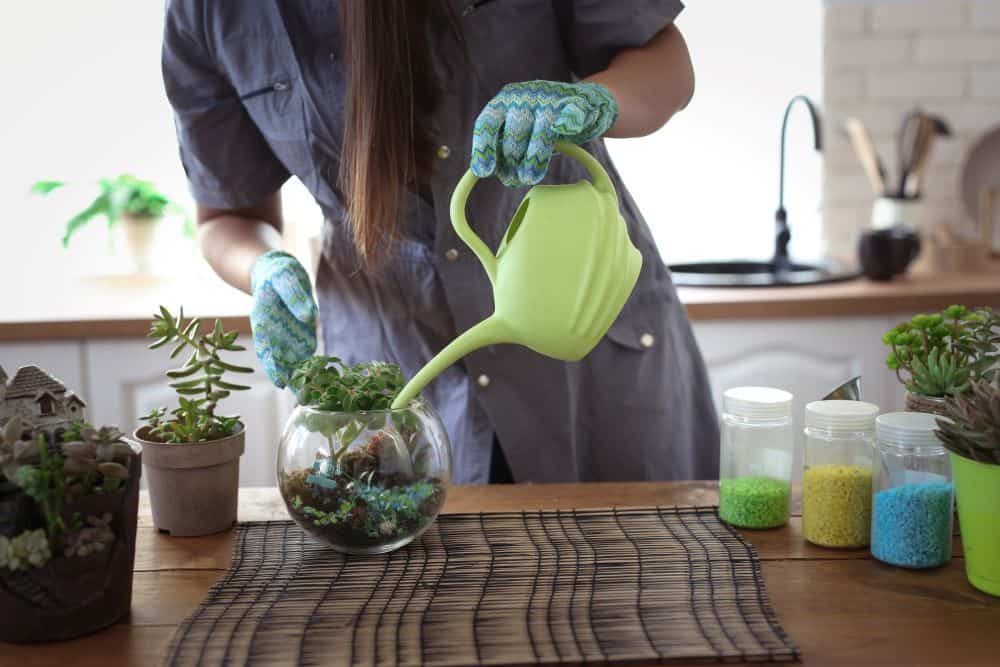
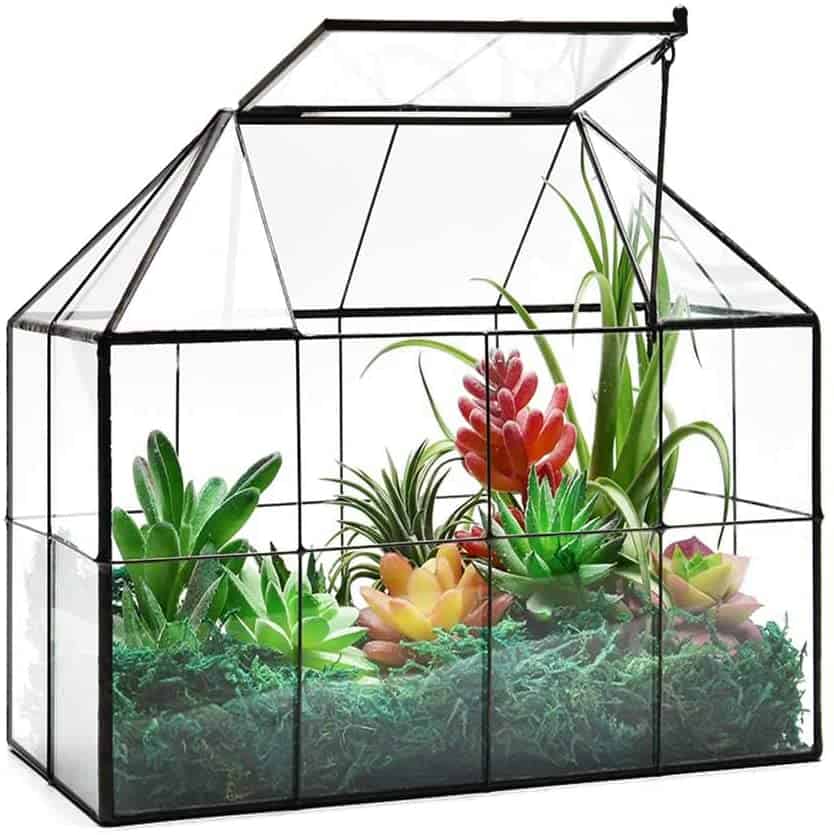

Leave a Reply